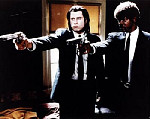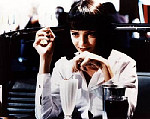Pulp Fiction

Personally, I had a lot of mixed feelings about Pulp Fiction. When I had first seen it a few months earlier, it was storming across the country, creating an avalanche of opinion. People either loved it or hated it. When I walked out of the screening, I was one of those who “hated it.” I felt it was way too long, had too much gratuitous violence and was much too talky. Basically, it was a “B” movie, shallow, exploitative, the epitome of everything I don’t like in the movies. Influential maybe, significant maybe, but in no way revolutionary, as I was defining the term.
After it first came out several people had confronted me with the film’s structure and “dared” me to analyze it in terms of the paradigm. As far as everybody was concerned, Pulp Fiction was it, innovative in thought, concept and execution, everything a revolutionary film should be. I had only seen it once and I simply said it didn’t fit my construct of a revolutionary film.
I finished speaking and was preparing to leave when I was approached by a man who was intrigued by my evaluation of Pulp Fiction. We chatted for a few moments and then he invited me to be a guest on the local NPR radio station. So I went to the station the next day, sat down, and the first question he asked me was what kind of an impact did I think Pulp Fiction might have on the young, emerging filmmakers. Was it a landmark film?

“Why?” the interviewer asked. I explained that Hollywood was in a period of change, comparable to the late 20s when sound was first introduced. At that time, through the desire to hear the actors “speak,” the camera was imprisoned inside a refrigerator and we lost the movement and fluidity of the camera we had attained during the Silent Era. All scenes had to be staged around the microphone. The actors entered the camera’s frame, spoke their lines and exited from the camera’s frame; the actors, the writers, the cameramen, were literally the prisoners of sound.
The screenwriters of the silent era did not know much about writing dialogue; their forte was telling stories with pictures, so Hollywood brought in Broadway playwrights to help them tell their stories in words, not pictures. That’s a theme F. Scott Fitzgerald touches on in his last novel, The Last Tycoon. Since that time, we’ve remained in a state of technological flux; black and white to Technicolor, standard screen size to Cinemascope, 35mm to 70mm, and now, computer graphics and digital technology. It’s the screenwriter who has really become the artisan of change because he or she must learn to use and adapt this new hi-tech awareness into their scripts.
“What do you think makes Pulp Fiction so influential?” the interviewer asked. I told him I had been confronted with that same question many times before and I still had no real answer. I concluded by saying that Pulp Fiction is definitely an influential film, may even be revolutionary and left it at that. Because it was such a hot topic of conversation, I thought I needed to look at it more closely.
When I returned home from Mill Valley, I got hold of the screenplay. When I opened it, I read on the title page that Pulp Fiction was really “three stories…about one story.” I turned the page and read two dictionary definitions of Pulp: “a soft, moist, shapeless mass of matter” and “a magazine or book containing lurid subject matter and being characteristically printed on rough, unfinished paper.” That’s certainly an accurate description of the film. But on the third page, I was surprised to find a Table of Contents.
That was odd, I thought; who writes a Table of Contents for a screenplay? I saw the film was broken down into five individual parts: Part I, was the Prologue; Part II, Vincent Vega and Marcellus Wallace’s Wife; Part III, The Gold Watch; Part IV, The Bonnie Situation, and Part V, the Epilogue.
As I studied the script, I saw that all three stories bounce off the inciting incident, the scene when Jules and Vinnie retrieve Marcellus Wallace’s briefcase from the four kids. I saw this one incident as the hub of all three stories, and noticed that each story is structured as a whole, in linear fashion; it starts at the beginning of the action, goes into the middle, then proceeds to the end. Each section is like a short story, presented from a different character’s point of view.

Suddenly, it all made sense. Understanding “three stories about one story” allowed me to see the film as one unified whole. Pulp Fiction is really three stories surrounded by a prologue and epilogue; what screenwriters call the “bookend” technique. Like The Bridges of Madison County (Richard LaGravenese), Sunset Boulevard (Billy Wilder and Charles Brackett), or Saving Private Ryan (Robert Rodat).
Now, I began to see how the film was put together. The Prologue sets-up Pumpkin and Honey Bunny (Tim Roth and Amanda Plummer) in a coffee shop discussing various types of small time robbery. When they finish their meal, they pull their guns and rob the place. The film freezes and we cut to the main titles. Then we cut into the middle of a conversation between Jules (Samuel L. Jackson) and Vinnie (John Travolta) driving, having an enlightening discussion about the relative merits of a Big Mac, both here and abroad.
This sets-up the entire film and tells us everything we need to know; the two men are killers working for Marcellus Wallace; their job, their dramatic need, is to retrieve the briefcase. That’s the true beginning of the story. In Part I, Jules and Vinnie arrive, state their position, kill the three guys, and it’s only by the grace of God they’re not killed. Vinnie takes Mia (Uma Thurman) out to dinner, and after her accidental overdose and rescue, they say good night. Part II is about Butch and his Gold Watch and what happens when he wins the fight instead of losing it like he had agreed to do. Part III deals with cleaning up Marvin’s remains splattered all over the car, a continuation of Part I. That’s followed by the Epilogue where Jules talks about his transformation and the significance of Divine Intervention and then Pumpkin and Honey Bunny resume the holdup that began the film in the Prologue.
It became clear to me that no matter what the form of the film, whether linear or non-linear, there is always going to be a beginning, a middle and an end. A film like Courage Under Fire (Patrick Shane Duncan) for example, or Groundhog Day (Danny Rubin, Harold Ramis), or The Usual Suspects (Chrisopher McQuarrie), or The English Patient (Anthony Minghella), or Momento (Chris Nolan), are all structured around a specific, inciting incident; only when that incident is shown does the story line split off into different directions. To build a non-linear movie means defining the parts, then structuring each part from beginning to end, at which point the screenwriter can put them into any order he or she desires.



Comments are closed.